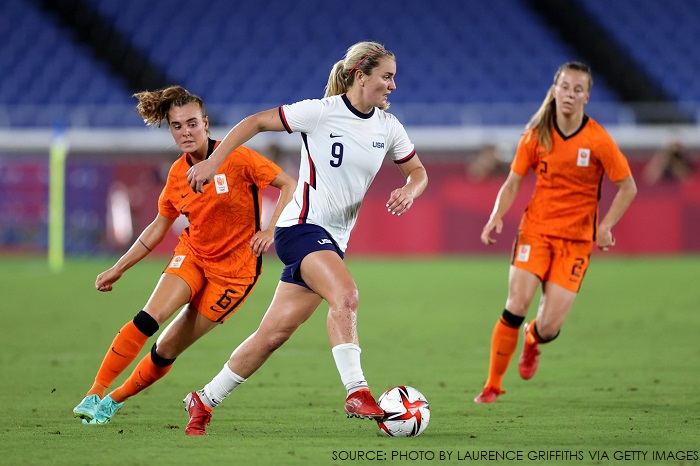Sports
Caitlin Clark’s Deal Signals New Era for Women’s Sports, Predicts Olympic Captain

- Lindsey Horan, co-captain of the U.S. Women’s National Team, prepares for her third Olympics, aiming to reclaim the gold medal.
- Despite significant financial opportunities, Horan highlights the ongoing disparity between men’s and women’s contracts in soccer.
- Horan remains optimistic about the growing investment and interest in women’s sports, seeing it as a path to greater equality and success.
Making it to the Olympics is “a non-stop grind,” says soccer star Lindsey Horan. The 30-year-old co-captain of the U.S. Women’s National Team is preparing for her third Olympics this summer after helping her team secure a bronze medal at the 2020 Tokyo Games.
“A lot of our success in partnerships and brands always comes around major tournaments,” explains Horan. However, she admits that there’s still a significant disparity between men’s and women’s contracts. Despite being the most expensive USWNT player, Horan earns just $1.5 million in on- and off-field earnings, according to Forbes.
“You look at contracts for teams in Europe for men’s soccer compared to women’s and it’s insane,” says Horan, who also plays for French club Olympique Lyonnais Féminin. “That’s millions and millions per week that you’re looking at.”
In 2022, five USWNT players reached an agreement with the U.S. Soccer Federation over an Equal Employment Opportunity Commission complaint citing unequal pay and treatment. Despite this, female soccer players at the 2023 Women’s World Cup earned just 25 cents for every dollar earned by men, according to a CNN analysis.
According to Forbes’ 2023 list of the world’s highest-paid athletes, the top three—Cristiano Ronaldo, Lionel Messi, and Kylian Mbappé—each made $120 million that year. In comparison, the top 15 highest-paid women in the 2023 World Cup collectively made less than a third of any of those individual players.
“It’s so crazy to look at some of these contracts and the investment in the men’s game,” Horan says. But she remains optimistic about the rising interest in women’s sports driving change.
She points out that while WNBA rookie Caitlin Clark’s starting pay is only $76,000, compared to the millions earned by NBA rookies like Victor Wembanyama, Clark has secured multi-million dollar sponsorship deals. This includes a rumored $28 million Nike deal, the richest for a women’s basketball player in history.
Clark, the No. 1 pick in the 2024 WNBA draft, has helped push the league to new highs, including a June 23 game against Angel Reese of the Chicago Sky that became the most expensive WNBA game on record, with an average ticket price of $271—more than three times higher than Sky’s average home game sale of $88, according to TickPick.
“It’s an investment we’ve talked about before, it just needs to keep growing, which I think it will because you see the way women’s sports is moving,” Horan says.
Sponsorships as a Key to Success
Soccer is big business, and as the USWNT continues to succeed, brands are taking notice. A prominent sign of the team’s popularity is the record sales of their home jersey, which Nike chief Mark Parker told The Wall Street Journal in 2019 was “the number one soccer jersey, men’s or women’s, ever sold on Nike.com in one season.”
Women’s soccer is also growing outside the Olympic stage. In November 2023, Yahoo Sports reported the NWSL’s four-year, “record-breaking” broadcast deal worth $240 million, with coverage across CBS, ESPN, Scripps Sports, and Amazon. Research firm SponsorUnited found that the number of brands buying sponsorships or media in the NWSL since 2019 was growing at four times the rate of Major League Soccer.
“A lot of brands are putting more and more investment, which has always been the goal. So that’s really exciting,” says Horan, who endorses eight major brands, including cherry juice brand Cheribundi, Microsoft’s Xbox, and Francis Ford Coppola’s winery. On her latest brand deal, Horan says, “Soccer is the love of my life, but those moments I get with my family having a glass of wine…I cherish them so much. I usually go for partnerships that I truly believe in…so it’s a really exciting partnership for me.”
Looking Ahead to the 2024 Olympics
As Horan sets her sights on this month’s Olympic Games, she’s leading the youngest U.S. women’s team since the 2008 Beijing Games. With newcomers like 19-year-old Jaedyn Shaw, the average age of this year’s team is 26.8 years, four years younger than the 2020 Tokyo Olympic team. Half the players are first-time Olympians, according to U.S. Soccer.
Horan, who has scored for the national team every year since 2015, says she has “full faith” in the young players. Her secret for a winning mindset? “To always exude confidence,” she told Fortune, crediting four years of work with her sports psychologist. “My main mentality, especially in the Olympics, is you go out and win the game,” she says. “It’s game by game.”
As Horan and her team prepare for the challenges ahead, their dedication and drive continue to inspire and pave the way for future generations of female athletes.
Source: Fortune


















































